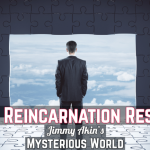
 Jimmy Akin's Mysterious World
Jimmy Akin's Mysterious World Reincarnation Research (Ian Stevenson)
Sep 8, 2023
Ian Stevenson, parapsychologist, discusses cases of reincarnation, including birthmarks and memories suggesting past lives. The chapter explores cryptomnesia, the use of psychics, and the significance of birthmarks. The speaker also discusses various cases involving children and explores cultural factors influencing reincarnation cases.
AI Snips
Chapters
Transcript
Episode notes
Gopal Gupta's Past Life Memories
- Gopal Gupta, a boy from India, spontaneously recalled a past life as Shakti Pals Sharma after age two.
- His detailed memories and behaviors matched the deceased's life and death, convincing the Sharma family of reincarnation.
Corliss Chotkin Jr.'s Identification
- Corliss Chotkin Jr. showed birthmarks matching his grandfather's scars and recalled his name and events.
- He exhibited behaviors and skills similar to the Tlingit ancestor he claimed to be, fading with age.
Susan Eastland's Past Life Signs
- Susan Eastland was born into a family that lost a child named Winnie and showed memories and behaviors matching Winnie.
- She identified Winnie's photographs as herself and had a birthmark matching Winnie's fatal injury.

 Belief in reincarnation is found in multiple world religions, but it is also studied from a scientific perspective today as well. Jimmy Akin and Dom Bettinelli discuss what parapsychologists have found about cases of the reincarnation type and ask what could explain their findings.
Belief in reincarnation is found in multiple world religions, but it is also studied from a scientific perspective today as well. Jimmy Akin and Dom Bettinelli discuss what parapsychologists have found about cases of the reincarnation type and ask what could explain their findings.